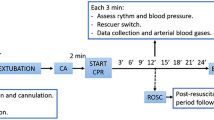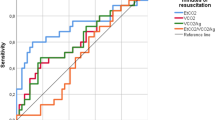Abstract
Objective
To examine the extents to which low tidal volume (VT) and endotracheal tube (ETT) leakeage influence the accuracy of ETCO2 for estimating arterial PCO2 (PaCO2) in very low birth weight (VLBW) infants with mechanical ventilation.
Study design
An observational study. We evaluated a total of 287 paired ETCO2 and PaCO2 values as well as VTs obtained from 22 VLBW infants with ventilation. Deming regression, quadratic discriminant analysis, and Bland–Altman analysis were performed.
Result
ETCO2 and PaCO2 were correlated (r2 = 0.5897, p < 0.0001). A quadratic discrimination analysis of the VT and the percentage of leak yielded 70.4% [95%CI, 65.1 to 75.7] discrimination for the agreement between ETCO2 and PaCO2. ETCO2 was strongly correlated with PaCO2 in the discriminant function Z > 0 group (r2 = 0.7234, p < 0.0001).
Conclusion
Our results indicate that ETCO2 is a good surrogate for PaCO2 when VT is high and ETT leak is low.
This is a preview of subscription content, access via your institution
Access options
Subscribe to this journal
Receive 12 print issues and online access
$259.00 per year
only $21.58 per issue
Buy this article
- Purchase on SpringerLink
- Instant access to full article PDF
Prices may be subject to local taxes which are calculated during checkout



Similar content being viewed by others
References
Erickson SJ, Grauaug A, Gurrin L, Swaminathan M. Hypocarbia in the ventilated preterm infant and its effect on intraventricular haemorrhage and bronchopulmonary dysplasia. J Paediatr Child Health. 2002;38:560–2.
Giannakopoulou C, Korakaki E, Manoura A, Bikouvarakis S, Papageorgiou M, Gourgiotis D, et al. Significance of hypocarbia in the development of periventricular leukomalacia in preterm infants. Pediatr Int. 2004;46:268–73.
Burton GW. The value of carbon dioxide monitoring during anaesthesia. Anaesthesia. 1966;21:173–83.
Bhende MS. End-tidal carbon dioxide monitoring in pediatrics—clinical applications. J Postgrad Med. 2001;47:215–8.
Salthe J, Kristiansen SM, Sollid S, Oglaend B, Soreide E. Capnography rapidly confirmed correct endotracheal tube placement during resuscitation of extremely low birthweight babies (<1000 g). Acta Anaesthesiol Scand. 2006;50:1033–6.
Foy KE, Mew E, Cook TM, Bower J, Knight P, Dean S, et al. Paediatric intensive care and neonatal intensive care airway management in the United Kingdom: the PIC-NIC survey. Anaesthesia. 2018;73:1337–44.
Takahashi D, Hiroma T, Nakamura T. PETCO2 measured by a new lightweight mainstream capnometer with very low dead space volume offers accurate and reliable noninvasive estimation of PaCO2. Res Rep. Neonatol. 2011;1:61–66.
Takahashi D, Matui M, Hiroma T, Nakamura T. A lightweight mainstream capnometer with very low dead space volume is useful monitor for neonates with spontanous and mechanical ventilation; Pilot study. Open J Pediatr. 2012;2:127–32.
Riker JB, Haberman B. Expired gas monitoring by mass spectrometry in a respiratory intensive care unit. Crit Care Med. 1976;4:223–9.
Geiser DR, Rohrbach BW. Use of end-tidal CO2 tension to predict arterial CO2 values in isoflurane-anesthetized equine neonates. Am J Vet Res. 1992;53:1617–21.
Scrivens A, Zivanovic S, Roehr CC. Is waveform capnography reliable in neonates? Arch Dis Child. 2019;104:711–5.
Kugelman A, Golan A, Riskin A, Shoris I, Ronen M, Qumqam N, et al. Impact of continuous capnography in ventilated neonates: a randomized, multicenter study. J Pediatr. 2016;168:e52.
Thompson JE, Jaffe MB. Capnographic waveforms in the mechanically ventilated patient. Respir Care. 2005;50:100–8. discussion 108–9
Tingay DG, Stewart MJ, Morley CJ. Monitoring of end tidal carbon dioxide and transcutaneous carbon dioxide during neonatal transport. Arch Dis Child Fetal Neonatal Ed. 2005;90:F523–526.
Contencin P, Narcy P. Study Group for Neonatology and Pediatric Emergencies in the Parisian Area Size of endotracheal tube and neonatal acquired subglottic stenosis. Arch Otolaryngol Head Neck Surg. 1993;119:815–9.
Deming WE. Statistical adjustment of data. NY: Dover Publications. Wiley; 1943.
Bland JM, Altman DG. Statistical methods for assessing agreement between two methods of clinical measurement. Lancet. 1986;1:307–10.
Hastie T, Tibshirani R, Friedman J. The elements of statistical learning. NY: Springer; 2001.
Motoyama EK, Davis PJ. Smith’s anesthesia for infants and children. 5th ed. St. Louis: CV Mosby, 1990.
Fisher DM. Anesthesia equipment for pediatrics. Pediatric anesthesia, 4th Edn New York: Churchill Livingstone. 2001:207–8.
Main E, Castle R, Stocks J, James I, Hatch D. The influence of endotracheal tube leak on the assessment of respiratory function in ventilated children. Intensive Care Med. 2001;27:1788–97.
Wenzel U, Wauer RR, Wagner MH, Schmalisch G. In vitro and in vivo assessment of the Ventrak 1550/Capnogard 1265 for single breath carbon dioxide analysis in neonates. Br J Anaesth. 1999;83:503–10.
Bernstein G, Knodel E, Heldt GP. Airway leak size in neonates and autocycling of three flow-triggered ventilators. Crit Care Med. 1995;23:1739–44.
Mahmoud RA, Proquitte H, Fawzy N, Buhrer C, Schmalisch G. Tracheal tube airleak in clinical practice and impact on tidal volume measurement in ventilated neonates. Pediatr Crit Care Med. 2011;12:197–202.
Schmalisch G, Al-Gaaf S, Proquitte H, Roehr CC. Effect of endotracheal tube leak on capnographic measurements in a ventilated neonatal lung model. Physiol Meas. 2012;33:1631–41.
Greer KJ, Bowen WA, Krauss AN. End-tidal CO2 as a function of tidal volume in mechanically ventilated infants. Am J Perinatol. 2003;20:447–51.
Vignaux L, Piquilloud L, Tourneux P, Jolliet P, Rimensberger PC. Neonatal and adult ICU ventilators to provide ventilation in neonates, infants, and children: a bench model study. Respir Care. 2014;59:1463–75.
Kim P, Salazar A, Ross PA, Newth CJ, Khemani RG. Comparison of tidal volumes at the endotracheal tube and at the ventilator. Pediatr Crit Care Med. 2015;16:e324–331.
Author information
Authors and Affiliations
Contributions
DT conceptualized and designed the study, designed the data collection instruments, collected data, carried out the initial analyses, drafted the initial manuscript, and reviewed and revised the manuscript. Koko G. designed the data collection instruments, collected data, and reviewed and revised the manuscript. Kei G. conceptualized and designed the study and critically reviewed the manuscript for important intellectual content. All authors approved the final manuscript as submitted and agree to be accountable for all aspects of the work.
Corresponding author
Ethics declarations
Conflict of interest
The authors have no conflicts of interest to declare.
Additional information
Publisher’s note Springer Nature remains neutral with regard to jurisdictional claims in published maps and institutional affiliations.
Rights and permissions
About this article
Cite this article
Takahashi, D., Goto, K. & Goto, K. Effect of tidal volume and end tracheal tube leakage on end-tidal CO2 in very low birth weight infants. J Perinatol 41, 47–52 (2021). https://doi.org/10.1038/s41372-020-0758-2
Received:
Revised:
Accepted:
Published:
Issue date:
DOI: https://doi.org/10.1038/s41372-020-0758-2
This article is cited by
-
Relationship between ETCO2 and PaCO2 under Changing Capnogram in Ventilated Infants with NAVA: An Observational Study
Indian Journal of Pediatrics (2024)



